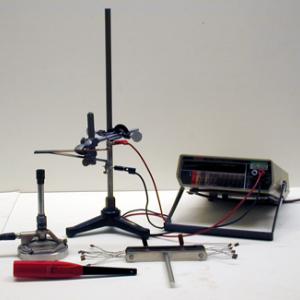College of Liberal Arts & Sciences
4A10.30 - Thermocouples
See also 5E50.10 in Electricity and Magnetism.
Hold the thermoelectric pair in the flame of the Bunsen burner after it is connected to the voltmeter. As the temperature of the pair goes up so should the voltage read on the voltmeter.
A variation on this experiment is to use the multiple thermal couple. Dip one end of this in liquid nitrogen and heat the other end with a Bunsen burner. A volt meter or a galvanometer may be used to look at the output.
- Thomas B. Greenslade, Jr., "19th Century Textbook Illustrations: Thermo-Electricity", TPT, Vol. 14, # 6, September 1976, p. 370.
- K. N. Chang, M. S. Cook, K. M. Hamlyn, and R. L. Chaplin, "Modern Thermocouple Experiment", AJP, Vol. 46, #11, Nov. 1978, p. 1080.
- Et-1: Freier and Anderson, A Demonstration Handbook for Physics.
- H- 014: "Thermocouple and Thermopile", DICK and RAE Physics Demo Notebook.
- John Moore, Christopher Davis, Michael Coplan, "Thermocouples", Building Scientific Apparatus, p. 511- 514.
- James Cunningham, "Electric Energy from Heat", Hands-On Physics Activities, p. 571, 584.
- Shoma Kutasov, "Dependence of Resistance in Metallic Conductors on the Temperature", Physics Demonstration, p. 142.
- "Calibration of a Thermocouple", Selective Experiments in Physics, CENCO, 1962.
- D. Colson, C. J. Lapp, J. A. Eldridge, "Experiment LXXV", 1936 Univ. of Iowa Physics Laboratory Manual, p. 85.
-
Brian Jones, "The Little Shop of Physics", TPT, Vol. 34, # 8, Nov. 1996, p. 514.
-
Leon H. Fisher, Robert N. Varney, "Contact Potentials Between Metals: History, Concepts, and Persistent Misconceptions", AJP, Vol. 44, #5, May 1976, p. 464.
-
"How to Make a Thermoelectric Battery", The Boy Scientist, p. 94.
-
Yaakov Kraftmakher, "5.8, Thermoelectric Phenomena", Experiments and Demonstrations in Physics, ISBN 981-256-602-3, p. 349.
-
James Cunningham, "Electric Energy from Heat", Hands-On Physics Activities, p. 571, 584.
-
John Moore, Christopher Davis, Michael Coplan, "Thermocouples", Building Scientific Apparatus, p. 511-514.
-
Shoma Kutasov, "Dependence of Resistance in Metallic Conductors on the Temperature", Physics Demonstration, p. 142.
-
Keithley Instruments, Roger D. Griffioen, "Physics Experiment # 5: Thermocouples and Temperature Transduceers", Series II.
-
Rudolf F. Graf, "Thermoelectricity - Producing Electricity from Heat", Safe and Simple Electrical Experiments, p. 81.
-
Julius Sumner Miller, Q149 & A149, Millergrams II – Some More Enchanting Questions for Enquiring Minds, p. 30 & 88.
-
Joseph Frick, "# 339 & 340 - Electrical Currents With One Metal & Currents Produced by Different Metals", Physical Technics: Or Practical Instructions for Making Experiments in Physics and the Construction of Physical Apparatus with the Most Limmited Means, p. 401.
-
D. Colson, C. J. Lapp, J. A. Eldridge, "Experiment LXXV", 1936 Univ. of Iowa Physics Laboratory Manual, p. 85.
Disclaimer: These demonstrations are provided only for illustrative use by persons affiliated with The University of Iowa and only under the direction of a trained instructor or physicist. The University of Iowa is not responsible for demonstrations performed by those using their own equipment or who choose to use this reference material for their own purpose. The demonstrations included here are within the public domain and can be found in materials contained in libraries, bookstores, and through electronic sources. Performing all or any portion of any of these demonstrations, with or without revisions not depicted here entails inherent risks. These risks include, without limitation, bodily injury (and possibly death), including risks to health that may be temporary or permanent and that may exacerbate a pre-existing medical condition; and property loss or damage. Anyone performing any part of these demonstrations, even with revisions, knowingly and voluntarily assumes all risks associated with them.
